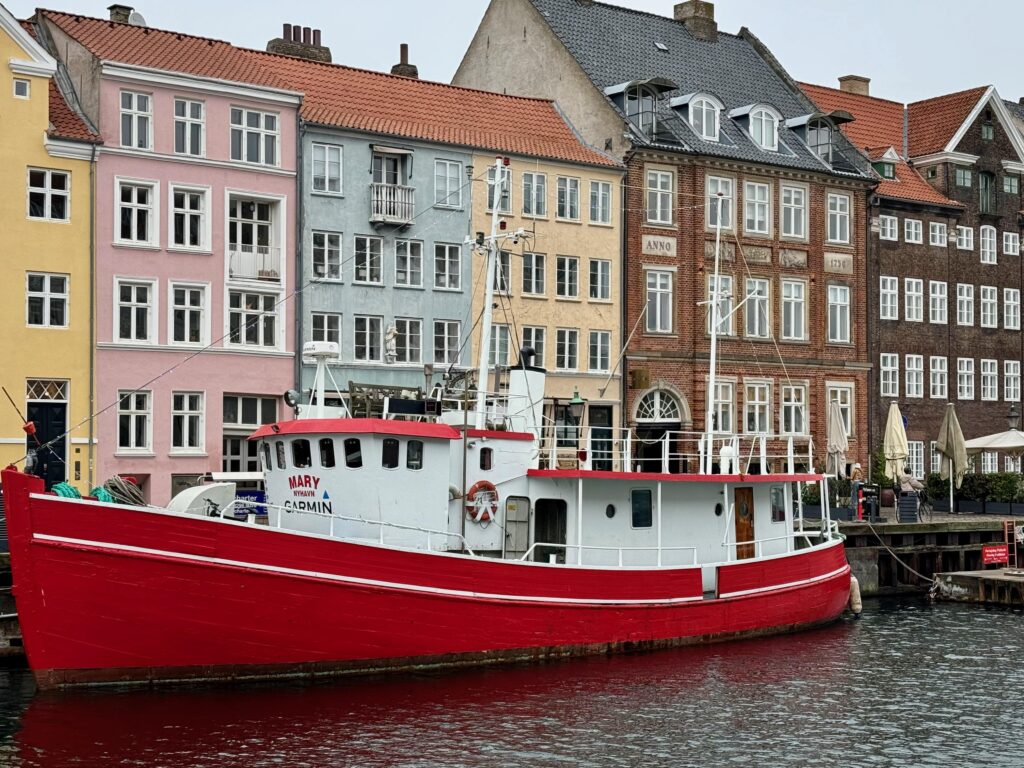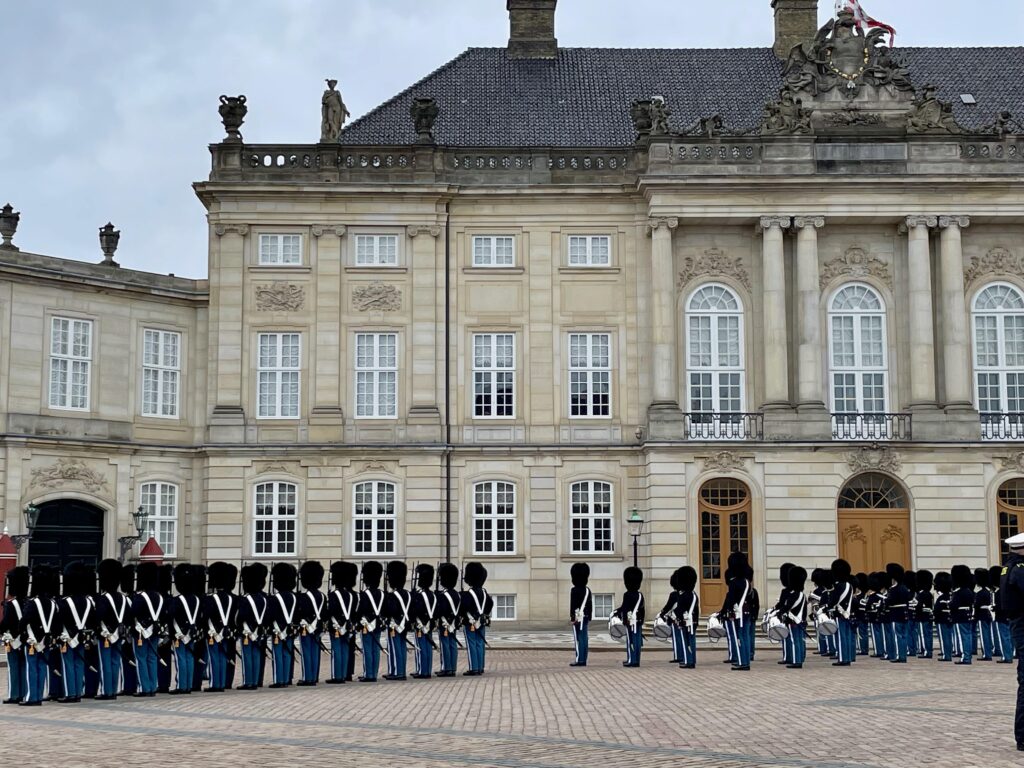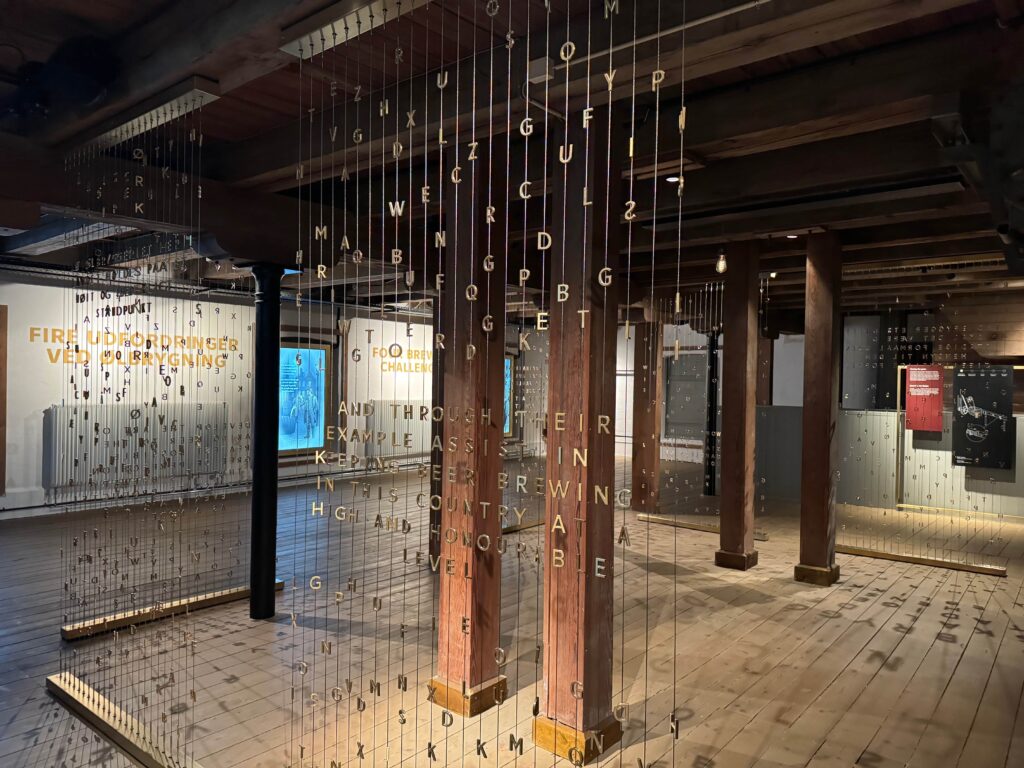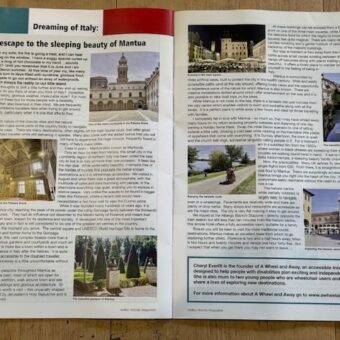Copenhagen – An accessible guide to Denmark’s capital city
A return visit to Copenhagen, this time with Stan as well. As an aspiring architect and keen photographer, this has been on his places to visit list for a while, with Copenhagen having been appointed European City of Architecture in 2023. And it did not disappoint!
Within seconds of stepping outside of our hotel, the camera was out and I was in my usual mode of hanging around on street corners while Stan snapped photos of interesting buildings from every angle and in every variation possible. Fortunately, I was well prepared with lots of layers!
With only two or three days we couldn’t even begin to cram in everything we wanted to do but it was a good start.
Danish Architecture Centre
The Danish Architecture Centre was clearly going to be an absolute. Housed in a dramatic building near the waterfront which spans both sides of the road, this is an interesting visit, even if architecture is not particularly your thing. With an ever-changing exhibition, this time it led us through the development of Danish architecture over a couple of hundred years, giving us a great insight into not just the buildings, but the social and political moods of the time. We learned about the monarchy, about the advent of communal living and the impact Danish architecture has had worldwide. For example, I never knew that the engineering answer to the Sydney Opera House iconic roofs came from a piece of discarded orange peel!
For those with a sense of adventure there is also an easy way to reach the ground floor exit when you have finished looking around the exhibition. A large tube winds round the interior to bring you sliding out to the bottom – little kids and big kids alike seemed to be enjoying it when we were there!

But while a visit to the DAC comes highly recommended, it is easy enough to get a taste of Copenhagen’s incredible architecture just by wandering around the city. From the modern industrial style buildings in Christianshavn, to the Round Tower, to the grand buildings that pepper every street, it is a beautiful city to get lost in for a few hours. Although, actually getting lost is not that easy! With a multitude of spires rising above the skyline it is always easy to find your way back to a central point and readjust your bearings. For us, it was always City Hall.
City Hall
City Hall is impossible to miss – dominating a large square just across from Tivoli Gardens the building was completed in 1905 and was the work of Danish architect Martin Nyrup. He was given complete free range in the design and the resultant building is a combination of both traditional Danish and northern Italian architecture. It makes a great grounding point to return to, as it is centrally located and easy to spot!

The Round Tower
The Round Tower is another must visit when in Copenhagen. Built by Christian IV in the seventeenth century, this unusual building was designed as an observatory. A brick slope winds around and around a central hollow core, almost to the top of the tower. Then three flights of stairs result in a fantastic three hundred and sixty degree view over the whole of Copenhagen. It is a great way to get a real sense of the city. Once again, the abundance of spires and domes strikes you.

How accessible is it?
In all honesty however, it is not completely accessible. For those with mobility difficulties it will be a challenge. Power chair users will be able to get almost to the top with relative ease. The ground is smooth, made of bricks laid side by side. Manual chair users will either need good upper body strength or a very game companion! Between Stan and I, we did get him to the top. There are a few places to rest and catch your breath on the way up should you need to. We certainly did!
The top of the slope affords a good view over the city. But for those with a little more mobility, the final flights of stairs are worth it if you can manage them. It is worth noting that the very final flight is narrow and only allows for one way traffic. As such, a light comes on telling you when to go up or down and there is only a limited amount of time to make it to the top before the direction changes. The stairs bring you up to the outside platform, from where you can view the city in all directions.
We were concerned that we would pay for our tickets and then find we couldn’t get very far. The ticket attendant at the entrance kindly allowed us to pay on the way out. This enabled us to see exactly how far we could get. It was with great triumph that we went to pay for our tickets on the way out!

Nyhavn
It is not necessary however to have biceps like Popeye to enjoy the diversity of Copenhagen’s architecture. Nyhavn is pronounced ‘noo-hown’, as I found, to my embarrassment, when the kindly person I asked for directions looked at me blankly. It is a gorgeously colourful collection of seventeenth and eighteenth century merchants’ houses, built along a canal which ends at the harbour. It is one of the most popular spots for tourists to visit when in Copenhagen. Even in February when we visited, there were lots of sightseers. But with good reason, as it is very pretty and it is rather nice to sit at one of the many pavement cafes and look at the wooden boats which inhabit the water.
Should you visit in the colder months do come well wrapped up though. Unfortunately, the historical nature of the buildings mean that many are not wheelchair accessible as they are down a few steep steps. There are more than enough outside options though, most coming equipped with heaters and a multitude of blankets. The steps aside, it is relatively easy to get around. It is cobbled but there are strips of pavement running amongst the cobbles, at the perfect width for a wheelchair’s wheels.
A very brief history of Nyhavn
Hans Christian Andersen, author of famous children’s stories such as ‘the Little Mermaid’ and ‘The Ugly Duckling’ lived here for a while and it all seems idyllic. Be aware however, that this gorgeous little enclave was a once a hotbed of debauchery! There were tattoo parlours, pubs and brothels, all doing a roaring trade from the sailors whose ships arrived here. This continued until the 1950’s. Some older residents still remember the sunny side of the canal being frequently referred to as the ‘Sin side’.



Amalienborg Palace
A short hop from Nyhavn brings you to the Amalienborg Palace, the official residence of the Danish monarchy. Immensely popular throughout the country, the relatively young King and Queen were only crowned in early 2024. This followed the abdication of Queen Margarethe after 52 years on the throne. The monarchy seems to be well loved, maybe partly because of the relatively simple lives they lead. They send their children to normal schools and go out and about, whether that be for a meal, shopping or something else, just like all regular families.
Should you wish to, you can find out more about the Danish royal family at https://www.wonderfulcopenhagen.com/wonderful-copenhagen/international-press/monarchy-denmark
At midday every day is the Changing of the Guard Ceremony. It is worth getting there a bit early to have a wander round the impressive square and watch everyone taking cheesy photos with the guards in their little red boxes. The ceremony itself is good to watch, feeling quite low key and in line with the laid-back attitude of city residents. I giggled when I saw one guard with his trainers on and his trousers caught up at the back. I couldn’t reconcile that with the immaculate presentation when watching the same ceremony in the UK but somehow rather liked it, as it definitely seemed in line with the general feeling of the city.


Copenhagen – atmosphere and accessibility
Copenhagen does feel inherently cool. While it is of course a capital city, there is a pervasive calm that is in evidence with every interaction you have. People are friendly, and it does not seem to have that hurried feel that characterises many big cities. I could easily imagine being here in the summer, enjoying one of the outdoor pools along the waterfront or sitting in a cafe, people watching.
It was an interesting visit as, when I came last year, I was immediately struck by how accessible everywhere was. There were wide pavements, plenty of drop kerbs and easy access to most of the buildings. Stan being with me gave us the opportunity to try it out more. I am delighted to say it was much as I remembered. There were perhaps a few more cobbles but even they were relatively smooth and didn’t cause much difficulty.
Many of the places we visited I had been to last year when I came alone. But it was great fun retracing my steps with Stan who always notices different things to me. It also meant that it was a bit easier when being photographers assistant as I already had an idea of the key things to look for!
Home of Carlsberg
However, something that was new to both of us was the Home of Carlsberg and how good was that?! It is housed in the original brewery and has only recently been renovated. We were fortunate enough to be amongst the first people to visit. Everyone is familiar with Carlsberg with its instantly recognisable ‘Probably the best…’ strapline. But did you know that the brand was established almost two hundred years ago in 1847? That it caused a huge family feud meaning that the founder and his son became bitter competitors and didn’t reconcile for many years? Or that this multi-billion-pound company donates around 30% of its profits annually to different charities and projects? Neither did we but we soon found out!
The attraction spans the history and the science behind creating the one of Denmark’s most famous brands. But more than simply a museum it is great fun with lots of interactive exhibits, meaning it will appeal to everyone. And the chance to immerse yourself in your own tailor-made beer is an opportunity not to be missed!
How accessible is it?
The team behind the exhibition have taken a great deal of care to ensure that it is accessible to everyone. And overall, they have done a very good job. It is probably ninety five percent accessible, with the bottle room being the only part that is completely off limits. This is a pity as it has a bottle of every beer produced in the world and it is impressive. They did try and make it accessible but unfortunately the historic nature and structure of the building rendered it impossible. But please don’t be put off as there is still way more than enough to make a visit worthwhile! And the team will offer every assistance. Book in advance when visiting. They will ensure that you are allocated a dedicated member of staff to provide any assistance you may need.




Is Copenhagen worth visiting?
There is so much to see and do in this beautiful city. There are beautiful buildings, amazing design, delicious food (Try out the fantastic food market at Torvehallen!), good shopping and lots more. We returned home feeling as though we had barely scratched the surface. It would have been good to see Tivoli Gardens, the world’s oldest amusement park, other than just peering through the metal gates. We wanted to see Grundtvig’s Church, on Copenhagen’s highest hill. We had hoped to ‘Meet the Danes’ at the National Museum. And we certainly didn’t do justice to Strøget, Europe’s longest shopping street. What a hardship, it just means that we will have to return….

Where to stay
We stayed for two nights at the Downtown Hostel located right in the centre, 500m from the Tivoli Gardens. The main entrance to the hostel is up a few steps but there is an alternative ramped entrance through the fire escape. It does require someone to let you in though, so if you are travelling with a companion that is fine. Otherwise, you will need to attract the attention of one of the staff to come and let you in. Once inside there is a lift in the communal area which will take you to all floors. We stayed in a twin room – the room itself was compact but with enough room to turn in a wheelchair. However, the bathroom was very compact with a small step. It would be unsuitable unless you can take a few steps.
We also stayed for two nights at the Tivoli Hotel and Congress Centre. This is a four-star hotel located down near the waterfront, around a ten to fifteen minute walk from the centre. We had an Executive Suite which was spacious and completely accessible with a. large bathroom, grab rails and plenty of room to manoeuvre. There was a large rug near the bed, but the rest of the flooring was solid. Far fancier than our normal fare, we thoroughly enjoyed it!
You can read more about visiting Copenhagen at https://awheelandaway.com/visiting-copenhagen-for-wheelchair-users/
Also, for more ideas on places to stay or things to do in Copenhagen please get in touch at https://awheelandaway.com/contact/. And similarly, if you have already sampled its delights and can offer any accessible tips then please do get in touch!






